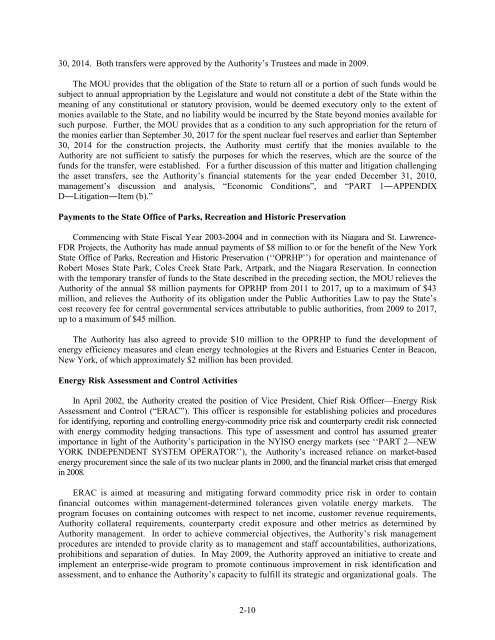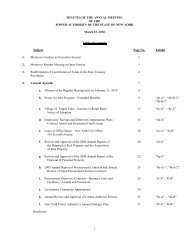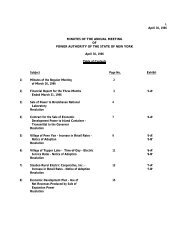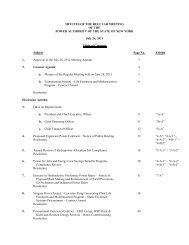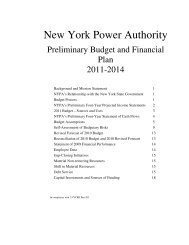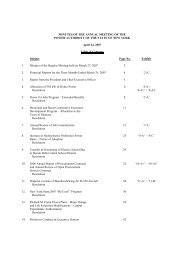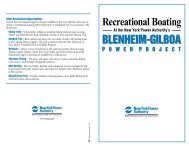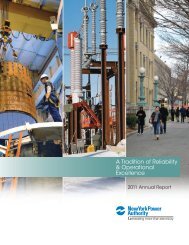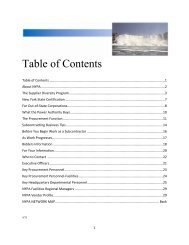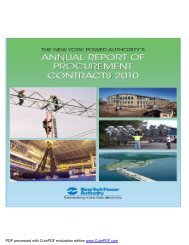July (pdf) - New York Power Authority
July (pdf) - New York Power Authority
July (pdf) - New York Power Authority
You also want an ePaper? Increase the reach of your titles
YUMPU automatically turns print PDFs into web optimized ePapers that Google loves.
30, 2014. Both transfers were approved by the <strong>Authority</strong>’s Trustees and made in 2009.<br />
The MOU provides that the obligation of the State to return all or a portion of such funds would be<br />
subject to annual appropriation by the Legislature and would not constitute a debt of the State within the<br />
meaning of any constitutional or statutory provision, would be deemed executory only to the extent of<br />
monies available to the State, and no liability would be incurred by the State beyond monies available for<br />
such purpose. Further, the MOU provides that as a condition to any such appropriation for the return of<br />
the monies earlier than September 30, 2017 for the spent nuclear fuel reserves and earlier than September<br />
30, 2014 for the construction projects, the <strong>Authority</strong> must certify that the monies available to the<br />
<strong>Authority</strong> are not sufficient to satisfy the purposes for which the reserves, which are the source of the<br />
funds for the transfer, were established. For a further discussion of this matter and litigation challenging<br />
the asset transfers, see the <strong>Authority</strong>’s financial statements for the year ended December 31, 2010,<br />
management’s discussion and analysis, “Economic Conditions”, and “PART 1―APPENDIX<br />
D―Litigation―Item (b).”<br />
Payments to the State Office of Parks, Recreation and Historic Preservation<br />
Commencing with State Fiscal Year 2003-2004 and in connection with its Niagara and St. Lawrence-<br />
FDR Projects, the <strong>Authority</strong> has made annual payments of $8 million to or for the benefit of the <strong>New</strong> <strong>York</strong><br />
State Office of Parks, Recreation and Historic Preservation (‘‘OPRHP’’) for operation and maintenance of<br />
Robert Moses State Park, Coles Creek State Park, Artpark, and the Niagara Reservation. In connection<br />
with the temporary transfer of funds to the State described in the preceding section, the MOU relieves the<br />
<strong>Authority</strong> of the annual $8 million payments for OPRHP from 2011 to 2017, up to a maximum of $43<br />
million, and relieves the <strong>Authority</strong> of its obligation under the Public Authorities Law to pay the State’s<br />
cost recovery fee for central governmental services attributable to public authorities, from 2009 to 2017,<br />
up to a maximum of $45 million.<br />
The <strong>Authority</strong> has also agreed to provide $10 million to the OPRHP to fund the development of<br />
energy efficiency measures and clean energy technologies at the Rivers and Estuaries Center in Beacon,<br />
<strong>New</strong> <strong>York</strong>, of which approximately $2 million has been provided.<br />
Energy Risk Assessment and Control Activities<br />
In April 2002, the <strong>Authority</strong> created the position of Vice President, Chief Risk Officer—Energy Risk<br />
Assessment and Control (“ERAC”). This officer is responsible for establishing policies and procedures<br />
for identifying, reporting and controlling energy-commodity price risk and counterparty credit risk connected<br />
with energy commodity hedging transactions. This type of assessment and control has assumed greater<br />
importance in light of the <strong>Authority</strong>’s participation in the NYISO energy markets (see ‘‘PART 2—NEW<br />
YORK INDEPENDENT SYSTEM OPERATOR’’), the <strong>Authority</strong>’s increased reliance on market-based<br />
energy procurement since the sale of its two nuclear plants in 2000, and the financial market crisis that emerged<br />
in 2008.<br />
ERAC is aimed at measuring and mitigating forward commodity price risk in order to contain<br />
financial outcomes within management-determined tolerances given volatile energy markets. The<br />
program focuses on containing outcomes with respect to net income, customer revenue requirements,<br />
<strong>Authority</strong> collateral requirements, counterparty credit exposure and other metrics as determined by<br />
<strong>Authority</strong> management. In order to achieve commercial objectives, the <strong>Authority</strong>’s risk management<br />
procedures are intended to provide clarity as to management and staff accountabilities, authorizations,<br />
prohibitions and separation of duties. In May 2009, the <strong>Authority</strong> approved an initiative to create and<br />
implement an enterprise-wide program to promote continuous improvement in risk identification and<br />
assessment, and to enhance the <strong>Authority</strong>’s capacity to fulfill its strategic and organizational goals. The<br />
2-10


